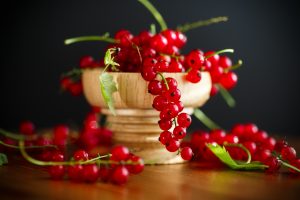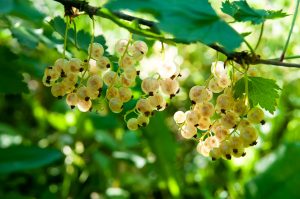Redcurrants produce abundant yields on old branches. A strange way to start an article perhaps but the truth is that when pruning is so important for gooseberries and blackcurrants but this is one fruit that doesn’t always obey the rules. The fruit has an incredible flavour and is highly versatile in both sweet and savoury dishes. It’s also beautifully attractive, with clusters of jewel-red carnelian fruit hanging like pendants from green, leafy branches.
Where To Grow
Redcurrants probably prefer cool conditions and they produce their best crops in colder climates. They also like sunlight although they will tolerate some partial shade such as under apple trees. However, the sweetest flavour is in those fruit enjoying a fair bit of sun. They also ripen quicker in a sunny position.
Place plants in a site that is not too affected by frost or strong, gusting winds. They like well-drained soil – not too claggy.
If space is an issue, grow as a multiple cordon or single-stem variety.
Planting
Bare-foot plants are probably best for getting established and these are usually planted at the end of Autumn which is late November to mid-December. (Remember, the first day of winter is not the 1st December but the 2st-22nd !) They can however be planted into the beginning of spring. Container grown specimens are put in the ground all year round. Place each bush about 1.5m apart, with the same spacing between rows. Once planted, water sufficiently, especially in hot weather.
Redcurrants do reasonably well in containers along as they have enough room. Problems like drying soil or waterlogging can occur. They need to be watered regularly and the tubs they are in should be off the floor using bricks so as to reduce root rot or waterlogging.
Aftercare
Established fruit bushes do not need further mollycoddling but always keep reasonably well watered especially the new plants. Remove any weeds from around the bushes using a hoe or hand weed when close to the stems.
Pruning is essential. Fruit is produced at the base of last year’s shoots and on the spurs of older wood. Pruning encourages formation of this wood.
Conduct all pruning in winter using secateurs. Any dead or diseased foliage is removed. Also snip back any branches which are obviously old and they will be past their best. At the beginning of summer, trim your bush so they retain a smaller size and shape. Do this by cutting fresh branches down to only two buds.
Harvesting
Pick bright white and red fruit from July to August. Protect berries from birds using netting and mesh curtains or ideally grow in a fruit cage. Given they grow in clusters, it is easy to pick the whole bunch and remove from the strig as and when necessary. eat fresh for best results otherwise consign them to that other great condiment, the redcurrant jelly which is an alternative to mint for lamb.
Pest
Birds are a shocking nuisance. We cover all our fruit with nets although they still get in underneath. Be careful as blackbirds regularly trap themselves.
Gooseberry sawfly not only attacks gooseberries (obviously) but also other Ribes species like redcurrants. All stages of the insect are damaging. The leaves are eaten by the larvae which look like speckled caterpillars. Remove these by hand where necessary. Check for their presence from April onwards and right up to the point of harvesting. Biological controls can be tried and these pathological nematodes are very effective.
Aphids – found on shoot tips.
Currant blister aphid – found in late spring on leaves at the shoot tips which produces blistering and puckering that later turns red.
Coral Spot Disease – pinhead-sized pink pustules that appear on the bark of dead wood, such as branch stumps. Cut off to prevent it spreading into the live wood.
Cultivar Selection
One of the most popular varieties is ‘Rovado‘ because it produces large attractive yields from mid-July and well into August. Also suitable for containers which makes it great for gardens with little room or just a patio. When space really is short than ‘Stanza’ AGM will cope better with container conditions. Most cultivars have unique characteristics so just spend time checking a type that suits the spot you want.
Redcurrant
cv. ‘Jonkheer van Tets‘ AGM – large, handsome fruit with long strigs and heavy cropping
cv. Red Lake AGM – High quality medium to large fruit: cropping on long trusses. Prone to wind damage in exposed sites.
cv. ‘Rovada‘ – Heavy cropping with long strigs of larger fruit, which makes it easy to harvest.
cv. ‘Stanza‘ AGM – medium-sized fruit: good quality with a compact habit. Will heavy crop.
Whitecurrant
cv. ‘White Grape‘ AGM – Attractive, translucent berries; good flavour
cv. ‘Blanka‘ – heavy cropping, ivory-coloured fruit.
cv. ‘Versailles Blanche‘ – strong upright growing. Heavy crops of pale yellow-white, sweet fruit.
Pinkcurrant
cv. ‘Gloire de Sablons‘ – Compact, upright habit, produces firm, translucent and pink aromatic fruit.
cv. Rosa Sport – medium vigour, has attractive, translucent pink berries with a mild and aromatic flavour.


Leave a Reply